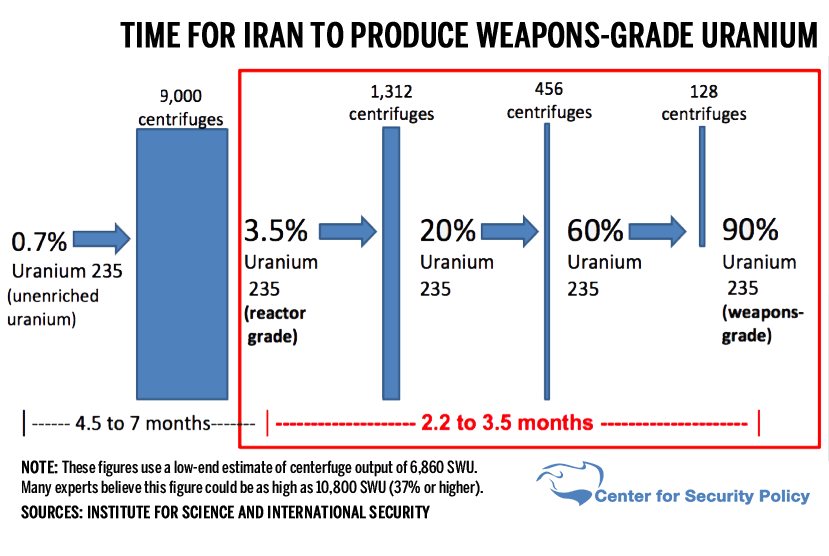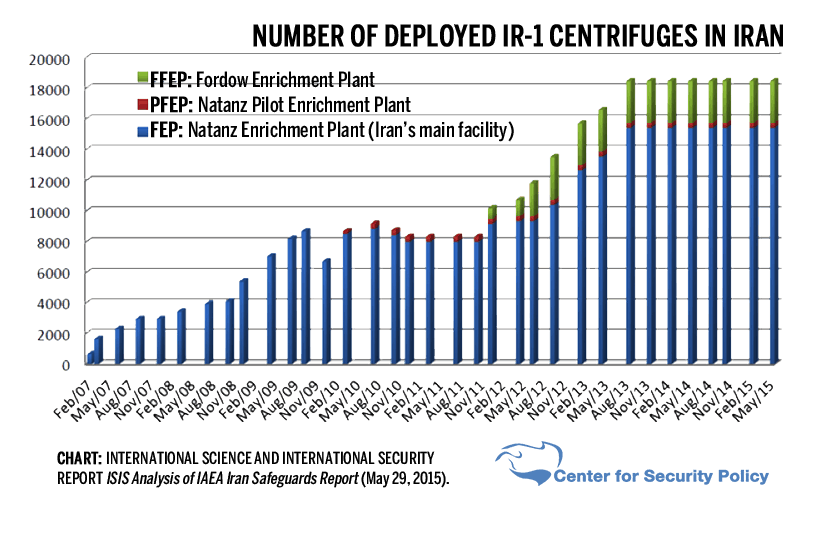Much of the discussion surrounding the nuclear talks with Iran concerns technical, scientific issues about how to make nuclear weapons. The most debated aspect of this process has been how to limit Iran’s uranium enrichment to halt or significantly slow its capability to build nuclear weapons. Share this:
There are three legs to a nuclear weapons program: producing nuclear fuel, constructing a nuclear warhead, and developing a delivery system. The most difficult leg is producing nuclear weapons fuel. Iran is believed to be pursuing two routes to do this: the uranium route and the plutonium route.
Uranium enrichment is the process of extracting from natural uranium the rare fissile isotope uranium-235 which comprises only 0.71% of natural uranium. “Fissile” means an element can undergo and sustain a nuclear fission reaction.
The purpose of enrichment is to concentrate the amount of U-235 so it can serve as a nuclear fuel either for a nuclear reactor or a nuclear weapon. Reactor-grade uranium is enriched to 3.5% to 5% U-235. Weapons-grade uranium is enriched to about 90% U-235. Iran has also enriched uranium to the 19.5% level allegedly to fuel a small research reactor in Tehran which requires uranium fuel enriched to this level.
Uranium enrichment is a complex, time-consuming and expensive process. Iran has attempted two enrichment techniques.
Iran experimented with a procedure called laser enrichment at a facility known as Lashkar Ab’ad in the late 1990s and early 2000s. This process enriches uranium by using high-intensity lasers to separate isotopes from a uranium vapor. This is an extremely complex process that no state is believed to have successfully used to produce kilogram-quantities of weapons-grade uranium. Iran reportedly ceased its laser enrichment program in 2003. However, former Iranian President Ahmadinejad said in 2010 it would be restarted. Other Iranian officials made statements in 2012 and early 2015 that Iran had made advances in uranium laser enrichment.
The Institute for Science and International Security, a Washington, DC arms control think tank, alleged in a 2013 paper that Iran’s laser enrichment program may never have been halted and remains a nuclear proliferation threat because production of nuclear fuel using this process is much easier to conceal than uranium enrichment or a heavy-water reactor, the method Tehran appears to be pursuing to produce plutonium.
Centrifuge enrichment is the principal technique Iran is using to produce nuclear fuel. This process involves spinning a gaseous uranium compound (uranium hexafluoride, UF6) at high speeds to separate out U-235. This is done is a series of centrifuge cascades to progressively increase the percentage of U-235.
After the UF6 is enriched to the desired level it is converted into uranium metal to be used either in reactor fuel rods or as nuclear weapons fuel.
The United States has long resisted allowing friendly states to enrich uranium since an enrichment program that is intended for peaceful purposes can easily be used to make nuclear weapons fuel. For example, in 2004, when South Korea was caught violating a bilateral agreement with the U.S. not to enrich uranium, Washington forced Seoul to halt this effort. The United States also was adamant when negotiating a 2009 agreement to share peaceful nuclear technology with the United Arab Emirates that it agree to forego uranium enrichment.
The Obama administration in 2012 reversed U.S. policy on Iranian uranium enrichment and proposed that Iran be permitted to enrich to the reactor-grade level if it dropped enrichment to the 20% level. This reversal was incorporated into the November 2013 interim agreement which is the basis of the nuclear talks with Iran that began in early 2014. Obama officials and many in the news media have portrayed reactor-grade enrichment as peaceful and posing little nuclear proliferation threat. The below chart illustrates how this is not true and shows how Iran could enrich reactor-grade uranium to weapons-grade in about 2.2 to 3.5 months.

Iran’s uranium enrichment program began in secret and in violation of its treaty obligations to inform the International Atomic Energy Agency of nuclear activities and research. Although six UN Security Council resolutions were passed between 2006 and 2010 calling on Iran to halt its uranium enrichment effort, Iranian leaders steadily expanded this program.
The chart below illustrates how the number of Iranian enrichment centrifuges increased since 2007.

This chart shows how the surge in Iranian uranium enrichment to the reactor-grade level has increased the number of nuclear weapons Iran could construct from zero in early 2009 to about nine as of June 2015.

According to a May 29, 2015 IAEA report, Iran had about 19,000 centrifuges of which approximately 9,156 were being used to enrich. These centrifuges use a primitive “IR-1” design which is based on a Pakistani design. The data in Figure 3 reflect enrichment using IR-1 centrifuges.
Iran is developing more advanced centrifuge designs that will be far faster and more resistant to breakdown that the IR-1 design. This could make the Iranian centrifuge program four to eight times more efficient. Although the nuclear agreement being negotiated with Iran reportedly will put some limits on development of advanced centrifuges, Iran will be allowed to continue to develop new designs during the agreement.
Iranian leaders have not been able to provide a convincing explanation to prove its uranium enrichment program is peaceful.
Iran has claimed its 9,000-plus centrifuges are intended to produce uranium to fuel its Bushehr power reactor. This cannot be true since about 200,000 centrifuges would be needed to fuel this reactor. It would be far more economical for Iran to buy fuel rods from other countries to fuel this reactor. Iran also has an agreement under which Russia is providing fuel rods for Bushehr until 2024. This agreement will probably be extended since Russia and Iran are negotiating other agreements for Russia to build more reactors in Iran.
Iranian officials also claim they need to enrich uranium to fuel the Tehran Research Reactor which is used to make isotopes for nuclear medicine applications. However, this explanation is also not plausible since Iran has far too many centrifuges for this purpose. Iran could purchase nuclear medicines and medical radiation sources of a far higher quality and at much less cost from other countries.
When asked at a June 1 briefing at the Capitol whether he thought a meaningful nuclear agreement with Iran was possible if Iran is allowed to continue to enrich uranium, former Senator Joseph Lieberman said:
“Quite simply and clearly no, I don’t. I mean, I thought the original purpose of these negotiations was to stop the Iranian nuclear enrichment program, in return for the sequential elimination of all the economic sanctions . . . To let that enrichment go on, to me just shows that, as Ayatollah Khamenei said himself last fall, the Americans obviously want this agreement much more than we do [and] that’s never where you want to be in a negotiation.”

During an October 4, 2014 interview with Fox News, Israeli Prime Minister Benjamin Netanyahu was more blunt about the purpose of Iran’s enrichment program: “They’re [Iran’s] making bombs. That’s what they’re trying to do. That’s what they’re whole program is about, making bombs.” Netanyahu also said that if President Barack Obama agreed to a “bad deal” with Iran that allowed Iran to keep “thousands of centrifuges,” he would be, in effect be “giving [the Iranians] the capacity in short order, a few weeks, a few months to operate those centrifuges, enrich enough uranium, that’s what you need, enriched uranium, to make a core of a nuclear bomb.”
Netanyahu also explained that why he disputes claims by Iranian officials that their centrifuge program is for peaceful uses. He said that although the Iranians “say they need it for civilian” non-military nuclear program, “That’s not true. 17 countries around the world, big countries, like Mexico and Canada and Indonesia and others, have civilian nuclear energy. They don’t have one centrifuge. Because the centrifuge you really need is for one thing, not for civilian nuclear energy, but for making a bomb, for military use.”
Qassem Suleimani is the commander of Quds Force, the elite faction of Iran’s Revolutionary Guards, is a veteran of decades…
Iran has long influenced the Middle East through the deployment of short ranged rockets and rocket artillery. They represent an…